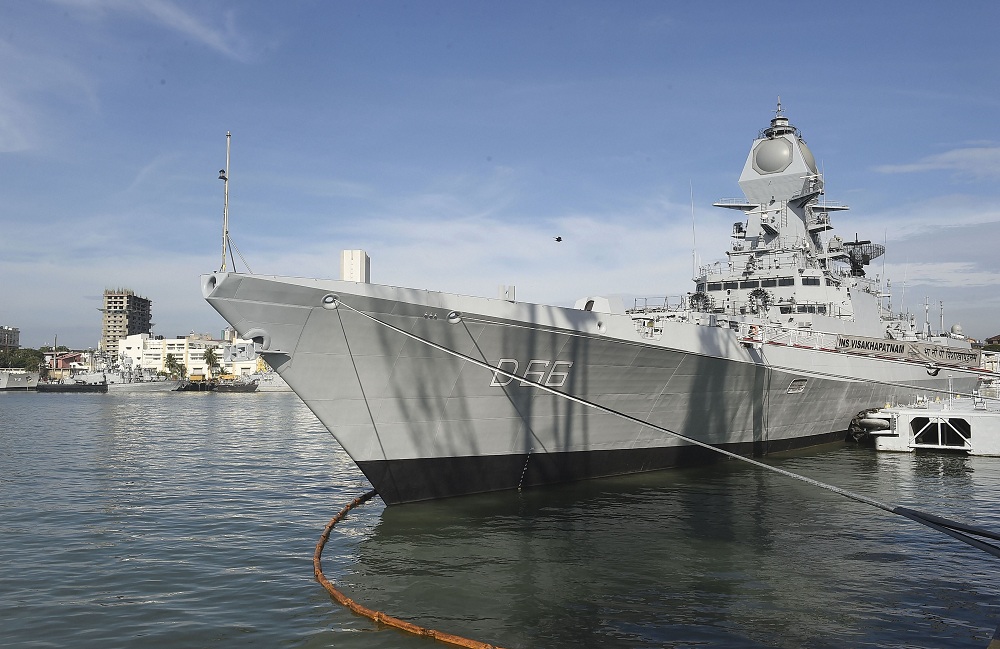
Guided-missile destroyer ship Visakhapatnam anchored at Naval Dockyard during its induction into the Indian Navy to boost combat capability in the Indian Ocean region, in Mumbai, Sunday, Nov. 21, 2021. Photo: PTI.
NEW DELHI (BNS/PTI): Indigenously-built stealth guided missile destroyer Visakhapatnam, packed with an array of missiles and anti-submarine rockets, was inducted into the Indian Navy on Sunday.
The induction ceremony, held at the Western Naval Command, was attended by Defence Minister Rajnath Singh and top naval commanders, officials said.
'Visakhapatnam' is equipped with lethal weapons and sensors, including supersonic surface-to-surface and surface-to-air missiles, medium and short-range guns, anti-submarine rockets and advanced electronic warfare and communication suits, officials said.
The ship has the capability of embarking two integrated helicopters and boasts of a very high level of automation with sophisticated digital networks, combat management systems and integrated platform management systems, they said.
It is the first stealth guided-missile destroyer of the Rs 35,000 crore Project 15B under which a total of four warships are being built.
The next ship is set to be commissioned in 2023 while the other two are planned to be inducted by 2025.
The warship has been designed by the Indian Navy's in-house organisation, the Directorate of Naval Design, and constructed by Mazagon Dock Limited.
The majestic ship measures 163 metres in length, 17 metres in breadth with a displacement of 7,400 tonnes.
"It can rightfully be regarded as one of the most potent warships to have been constructed in India," said an official.
The ship, propelled by four powerful gas turbines, is capable of achieving speeds in excess of 30 knots.
It is fitted with a modern surveillance radar that provides target data to the gunnery weapon systems of the ship, the official said.
The ship's anti-submarine warfare capabilities are provided by the indigenously developed rocket launchers, torpedo launchers and anti-submarine warfare helicopters.
The ship is also equipped to fight under nuclear, biological and chemical (NBC) warfare conditions, the official said.
"The commissioning of Visakhapatnam will reaffirm India's presence amongst an elite group of nations with capability to design and build advanced warships," Vice Admiral Satish Namdeo Ghormade, the Vice Chief of Naval Staff, said on Tuesday.
With the changing power dynamics in the Indian Ocean region, INS Visakhapatnam will augment the Indian Navy's mobility, reach and flexibility towards accomplishment of its tasks and goals, Defence Minister Rajnath Singh said. The indigenously-built stealth guided missile destroyer, packed with an array of missiles and anti-submarine rockets, was commissioned in presence of top naval commanders.
Visakhapatnam is equipped with lethal weapons and sensors, including supersonic surface-to-surface and surface-to-air missiles, medium and short-range guns, anti-submarine rockets and advanced electronic warfare and communication suits, officials said.
INS Visakhapatnam measures 163 metres in length and 17 metres in breadth with a displacement of 7,400 tonnes. The ship is propelled by four powerful gas turbines, in a Combined Gas and Gas (COGAG) configuration, capable of achieving speeds in excess of 30 knots. The ship is also packed with sophisticated state-of-the-art weapons and sensors such as surface-to-surface missile and surface-to-air missiles. It is fitted with a modern surveillance radar which provides target data to the gunnery weapon systems of the ship. The anti-submarine warfare capabilities are provided by the indigenously developed rocket launchers, torpedo launchers and Anti-Submarine Warfare (ASW) helicopters. The ship is equipped to fight under Nuclear, Biological and Chemical (NBC) warfare conditions, officials said. Some of the major indigenised equipment/system onboard INS Visakhapatnam include Combat Management System, Rocket Launcher, Torpedo Tube Launcher, Integrated Platform Management System, Automated Power Management System, Foldable Hangar Doors, Helo Traversing system, Close-in Weapon System and the Bow mounted SONAR, an official said.
Singh termed INS Visakhapatnam as a symbol of the growing maritime prowess of the country. Listing out the steps taken by the government to give indigenisation a boost, Singh also urged to 'Make in India, Make for the World'. Admiral Karambir Singh, Chief of the Naval Staff, said the ship is a shining example of self-reliance.
The Navy chief said 39 of the 41 ship and submarine orders have been given to Indian shipyards, which is a testament to their commitment for achieving self-reliance.
The defence minister described the development of Indigenous Aircraft Carrier 'INS Vikrant' as an important milestone in the path of 'Aatmanirbhar Bharat'.
The carrier will increase our reach from the Indian Ocean to the Pacific and Atlantic Ocean. Its commissioning will be a golden moment in the history of Indian defence. It will be the best occasion to celebrate the 75th anniversary of India's independence and the 50th anniversary of India's victory in 1971 war, the minister said.
 Previous Article
Previous Article













The Indian Air Force, in its flight trials evaluation report submitted before the Defence Ministry l..
view articleAn insight into the Medium Multi-Role Combat Aircraft competition...
view articleSky enthusiasts can now spot the International Space Station (ISS) commanded by Indian-American astr..
view article